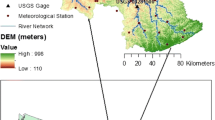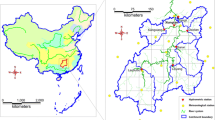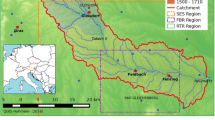Abstract
The effect of land use change on drying streams was evaluated using a grid-based continuous hydrological model (PGA-CC). For a drying stream-progressed watershed (398.8 km2), the model was calibrated and validated using 7 years (2005–2011) of streamflow data at the watershed outlet with an average Nash–Sutcliffe model efficiency of 0.71. Based on the model simulation results for 36 years (1976 to 2011), both land use change and climate change decreased the 10-day minimum flow by 0.16 m3/s and increased the day counts below the annual average by 40.6 days/year. These changes resulted from the 8.7 % increase in urban area, 1.43-fold increase in groundwater use, and 1.1 °C temperature increase during the 36-year period. From the distributed results of the model, we identified the drying stream location and progression. The spring and winter seasons were relatively strongly affected, and drying streams were identified in more urbanized areas with greater groundwater use.






Similar content being viewed by others
References
Ahn SR, Kim SJ (2014) Assessment of climate change impacts on the future hydrologic cycle of the Han river basin in South Korea using a grid-based distributed model. Irrig Drainage (in press)
Antrop M (2004) Landscape change and the urbanization process in Europe. Landsc Urban Plan 67:9–26
Barron OV, Barr AD, Donn MJ (2013) Effect of urbanisation on the water balance of a catchment with shallow groundwater. J Hydrol 485:162–176. doi:10.1016/j.jhydrol.2012.04.027
Beven K (1982) On subsurface stormflow: predictions with simple kinematic theory for saturated and unsaturated flows. Water Resour Res 18:1627–1633. doi:10.1029/WR018i006p01627
Bhaduri B, Harbor J, Engel B, Grove M (2000) Assessing watershed-scale, long-term hydrologic impacts of land-use change using a GIS-NPS model. Environ Manag 26:643–658. doi:10.1007/s002670010122
Chen X, Shu L (2006) Groundwater evapotranspiration captured by seasonally pumped wells in river valleys. J Hydrol 318:334–347. doi:10.1016/j.jhydrol.2005.06.025
Collin ML, Melloul AJ (2003) Assessing groundwater vulnerability to pollution to promote sustainable urban and rural development. J Clean Prod 11:727–736. doi:10.1016/S0959-6526(02)00131-2
DeFries R, Eshleman KN (2004) Land-use change and hydrologic processes: a major focus for the future. Hydrol Process 18:2183–2186. doi:10.1002/hyp.5584
Dietz ME, Clausen JC (2008) Stormwater runoff and export changes with development in a traditional and low impact subdivision. J Environ Manag 87:560–566. doi:10.1016/j.jenvman.2007.03.026
Du J, Qian L, Rui H, Zuo T, Zheng D, Xu Y, Xu C (2012) Assessing the effects of urbanization on annual runoff and flood events using an integrated hydrological modeling system for Qinhuai River basin, China. J Hydrol 464:127–139. doi:10.1016/j.jhydrol.2012.06.057
Haase D (2009) Effects of urbanisation on the water balance – A long term trajectory. Environ Implant Assess Rev 29:211–219. doi:10.1016/j.eiar.2009.01.002
Hong WY, Park GA, Jeong IK, Kim SJ (2010) Development of a grid-based daily watershed runoff model and the 13 evaluation of its applicability. J Korean Soc Civ Eng 30:459–469
Kim SJ, Chae HS (1998) Development of GRid-based Soil Moisture Routing Model (GRISMORM) applied to Bocheongchun watershed. J GIS Assoc Korea 7:39–48
Kim SJ, Chae HS, Yoo CS, Shin SC (2003) Stream discharge prediction via a grid-based soil water routing with paddy fields. J Am Water Resour Assoc 39:1143–1155. doi:10.1111/j.1752-1688.2003.tb03698.x
Kim SJ, Kwon HJ, Park GA, Lee MS (2005) Assessment of land-use impact on streamflow via a grid-based modelling approach including paddy fields. Hydrol Process 19:3801–3817. doi:10.1002/hyp.5982
Kim SJ, Park GA, Lee YG, Ahn SR (2014) Development of a meso-scale distributed continuous hydrologic model and application for climate change impact assessment to Hanriver basin. J Korean Assoc Geogr Inf Stud 17(3):160–174
Legates DR, McCabe GJ (1999) Evaluating the use of “goodness-of-fit” measures in hydrologic and hydroclimatic model validation. Water Resour Res 35:233–241. doi:10.1029/1998WR900018
Ministry of Agriculture, Food and Rural Affairs (2012) Food, agriculture, forestry and fisheries statistical yearbook
Ministry of Land, Infrastructure, and Transport (MLIT) (2009) A study on evaluation of drying stream and improvement
Nash JE, Sutcliffe JV (1970) River flow forecasting through conceptual models: part I. A discussion of principles. J Hydrol 10:282–290. doi:10.1016/0022-1694(70)90255-6
Ott B, Uhlenbrook S (2004) Quantifying the impact of land-use changes at the event and seasonal time scale using a process-oriented catchment model. Hydrol Earth Syst Sci 8:62–78. doi:10.5194/hess-8-62-2004
Rose S, Peters NE (2001) Effects of urbanization on streamflow in the Atlanta area (Georgia, USA): a comparative hydrological approach. Hydrol Process 15:1441–1457. doi:10.1002/hyp.218
Rural Research Institute (2006) A study on causative factors of drying streams in rural area
Sanders RA (1986) Urban vegetation impacts on the hydrology of Dayton, Ohio. Urban Ecol 9:361–376. doi:10.1016/0304-4009(86)90009-4
Santhi C, Arnold JG, Williams JR, Dugas WA, Srinivasan R, Hauck LM (2001) Validation of the SWAT model on a large river basin with point and nonpoint sources. J Am Water Resour Assoc 37:1169–1188. doi:10.1111/j.1752-1688.2001.tb03630.x
Schoonover JE, Lockaby BG, Helms BS (2006) Impacts of land cover on stream hydrology in the West Georgia Piedmont, USA. J Environ Qual 35:2123–2131. doi:10.2134/jeq2006.0113
Sloan PG, Moore ID (1984) Modelling subsurface streamflow on steeply sloping forested watersheds. Water Resour Res 20:1815–1822
Verhoef A, Feddes RA (1991) Preliminary review of revised FAO radiation and temperature methods. Land and Water Division FAO, Rome
Wang Y, Choi W, Deal BM (2005) Long-term impacts of land-use change on non-point source pollutant loads for the St. Louis metropolitan area, USA. Environ Manag 35:194–205. doi:10.1007/s00267-003-0315-8
Acknowledgments
This research was supported by a grant (16AWMP-B079625-03) from the Water Management Research Program funded by the Ministry of Land, Infrastructure, and Transport of the Korean government.
Author information
Authors and Affiliations
Corresponding author
Rights and permissions
About this article
Cite this article
Jung, C.G., Kim, S.J. Evaluation of land use change and groundwater use impact on stream drying phenomena using a grid-based continuous hydrologic model. Paddy Water Environ 15, 111–122 (2017). https://doi.org/10.1007/s10333-016-0533-3
Received:
Revised:
Accepted:
Published:
Issue Date:
DOI: https://doi.org/10.1007/s10333-016-0533-3




